Developing Family Entertainment Centers for Smaller Markets New Prototype Planned for Dodge City, Kansas, USA
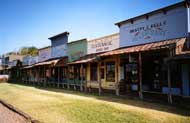 |
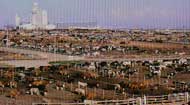 |
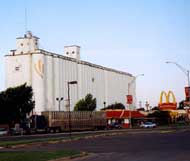 |
| The Boot Hill Museum includes a reproduction of the original Front Street | Typical cattle feed lot in southwest Kansas where 1,000's of cattle are raised. | Scene on Wyatt Earp Boulevard, the main east-west street in Dodge City. Shows a typical grain silo where wheat and other grains are stored, a cattle transport truck hauling cattle to a local processing plant, and a McDonald's restaurant, where grain is consumed as bread sandwich buns and beef is consumed as hamburgers. |
There are many smaller cities and towns where there is no or little regular entertainment for families with children. These markets obviously have demand for a family entertainment center (FEC).
However, when it comes to the economic feasibility of a FEC, the problem with most smaller markets is that adequate revenues cannot be generated to pay expenses, the cost of financing and a reasonable return on invested capital. The problem is that the investment required to develop a FEC can only be scaled down so far before the formula no longer works. A miniature golf course cannot be smaller than 18 holes. A go-kart track needs to be at least 800 feet long to offer a good entertainment experience. There needs to be several dozen games to offer adequate variety. There needs to be a critical mass and mix of indoor attractions for an indoor FEC to have adequate appeal and draw. So in many smaller markets, the cost of developing an FEC cannot be scaled down to match potential attendance and revenues.
The other issue is customer expectations. Consumers today travel widely. Residents of smaller cities and towns have visited major metropolitan areas and entertainment facilities there. This sets an expectation level that needs to be matched to create perceived value. Reducing the mix, variety and level of finishes of an FEC below a certain level only results in customers perceiving the FEC as inferior, not worth the visit and cost, not a good value. Customers always have the option of just staying home-and they will exercise that option if they are not offered the required level of experience and value to meet their expectations.
For years we have been challenged and frustrated by this smaller market dilemma-the market wants it and will support it, but the economics won't work. The economics basically boil down to three factors-attendance, per capital expenditures and cost. When these are in the right ratio, the economics work-the bills get paid, the bank gets paid and investors earn a market rate return on their investment. Getting the ratio wrong quickly results in financial disaster.
There have been a number of occasions when we have performed feasibility studies and told our clients the market isn't large enough, not to proceed. We don't enjoy shattering someone's dream, but it is sure better than chasing the dream and ending up in bankruptcy court.
Whenever possible, as part of our feasibility work, we try to find a formula that will work for our clients. A feasibility study deals as much with what will work and work best, as it does with whether the market is large enough. And sometimes our clients challenge us to find new approaches, new formulas to push the market envelop smaller.
In September 2001, Randy White, our CEO, wrote an article published in a trade magazine that said "Even in the smallest markets, it still takes a minimum of about 20,000 square feet for an indoor FEC to make the formula work with sufficient variety and critical mass, assuming sufficient market demand exists to support that level of investment."
Several months later we were eating our words when a new client put us to the challenge to develop a smaller size children's edutainment center. Although the market was more than an adequate size, the client only had so much space available. So we took on the design challenge and came up with a design that requires about 13,000 square feet, without sacrificing critical mass or quality.
Now, a new client in Dodge City, Kansas-the place famous as the meanest, wildest town in the old Wild West, home of lawmen Wyatt Earp and Bat Masterson-has put us to the challenge to develop a new prototype for a smaller market where the economics will work.
Dodge City only has a population of 25,000. Like many areas in the southwest US, its population is mixed Anglo and Hispanic/Latino (43%). Its trade area population is much greater than 25,000, since it is a shopping and leisure destination for the surrounding rural farm area communities and smaller towns. And it has a moderate amount of tourism due to its history and the popular Boot Hill Museum.
We are still in the feasibility and concept development stage, but our preliminary research and findings indicate that the new prototype we are developing will allow us to lower the minimum size market required to make FEC economics work by:
- increasing frequency of visits by making food a draw, rather than only entertainment being the draw and food just an impulse sale,
- creating an indoor and outdoor mix with strong multi-generational appeal to families, including families with younger children who are so often neglected with typical FEC formulas,
- making the center a special celebration destination, thus increasing its market reach and its revenues, and
- maximizing non-peak time revenues.
As part of our development of the small market FEC prototype, we are working with an international pizza company and a large amusement games supplier to putting together a development package that will also include training, start-up assistance and on-going support to help assure success. Games are an important component of any FEC concept. Success requires a good selection, replacing games as new ones become available, and expertise in redemption. The development package will include either a games revenue-share or rental program that has a built-in replacement component, to assure the games selection stays fresh.
History of Dodge City
Dodge City is a pure definition of the West ... a gateway to history that began with the opening of the Santa Fe Trail by William Becknell in 1821 and became a great commercial route between Franklin, Missouri and Santa Fe, New Mexico until 1880. Wagon wheel ruts along the original Trail can still be seen in the sod 9 miles west of Dodge City at a National Park site. The trail passed through Westport in Kansas City, Missouri, current home of White Hutchinson's office. Back in the 1800's, it took a wagon train up to 8 weeks to reach Dodge City. Today, we can fly there from Kansas City in a little over one hour's time.
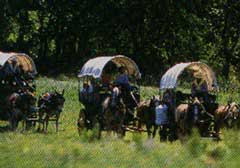
The original settlers of the American West traveled by Wagon Train to reach what would be their new homes.
Thousands of wagons traveled the Mountain Branch of the Santa Fe trail which went west from Dodge City along the north bank of the Arkansas River into Colorado. For those willing to risk the dangers of waterless sand hills, a shorter route called the Cimarron Cutoff crossed the river near Dodge City and went southwest to the Cimarron River.
In those days, safety from marauding Indians was essential. Fort Dodge was established in 1865 on the Santa Fe Trail near the present site of the city, offering protection to wagon trains, the U.S. mail service and serving as a supply base for troops engaged in the Indian Wars. Kiowa, Cheyenne and other plains tribes inhabited the area and wild game was abundant, including vast herds of American buffalo (they are actually bison, no a member of the buffalo family).
Just six years later in 1871, five miles west of the Fort at the foot of a hill along the Trail, a rancher by the name of Henry L. Sitler constructed a three-room sod house. Built to oversee his cattle ranch, Sitler's home became a frequent stopping place for buffalo hunters and traders. Dodge City was founded the next year, 1872, with the Sitler's home as the first building. It quickly became a trade center for travelers and buffalo hunters.
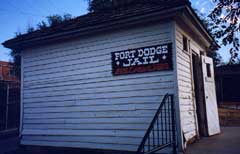
Preserved original Fort Dodge jail, built about 1865.
In September of 1872, the shiny steel rails of the brand new Atchison, Topeka and Santa Fe railroad stretched into view. The railroad initiated a tremendous growth for many years. Already, south of the tracks, hastily built frame buildings and tents housed two grocery and general merchandise stores, a dance hall, a restaurant, a barber shop, a blacksmith shop - even a saloon next to Sitler's original sod house. The famous Front Street legend had begun. Dodge City was already setting a record for growth.
Stacks of Buffalo hides towered along Front Street - filthy Buffalo hunters and traders filled the town's establishments - and the term "stinker" was coined. Train-masters would take their red caboose lanterns along when visiting the town's "soiled doves" (brothels) - and the term "red light district" came to life.
But during those early years, Dodge City also acquired its infamous stamp of lawlessness and gun-slinging. There was no local law enforcement and the military had no jurisdiction over the town. Buffalo hunters, railroad workers, drifters and soldiers scrapped and fought, leading to the shootings where men died with their boots on. And that created a hasty need for a local burial place - Boot Hill Cemetery where they were often buried in shallow graves with their boots still on sticking out of the ground. The cemetery is now a part of the Boot Hill Museum in downtown Dodge City. The cemetery was used until 1878.
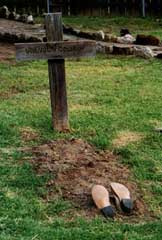
Boot Hill Cemetery
For six years before Boot Hill, Dodge City had no official cemetery. Persons dying who had friends, enough money or sufficient standing in the community were buried in the post cemetery at Fort Dodge. Others, penniless or unknown, were buried where it was convenient to dig a hole.
Dodge City was the Buffalo capital of the West for three years. An estimated 850,000 buffalo hides were shipped from Dodge City in the years 1872-1874. Then in 1874, a mass slaughter destroyed the huge herds, left the Prairie littered with decaying carcasses and helped drive US buffalo almost to extinction (not one of prouder moments in US environmental history). The slaughter was ordered by the US government at the urging of the US Army. Even with Fort Dodge, the Army found itself unable to protect the wagon trains and area residents from Indians. It was decided that the government could rid the area of the Indians by destroying all the buffalo, as buffalo were the center of life for the Plains Tribes of Native Americans, providing them with food, shelter, clothing and spiritual inspiration for their survival. Indian legend tells "the Great Spirit brought the pipe to the people. She came as a young woman wearing a white buckskin dress and moccasins. After the Great Spirit presented the pipe to the people and explained the significance of that pipe, she left the teepee as a white bison calf."
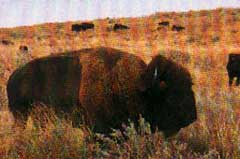
An American buffalo (bison)
Farmers, during hard times, gathered the Buffalo bones and sold them for six to eight dollars a ton. The bones were used in the manufacture of china and fertilizer. By 1875 the Buffalo were gone as a source of revenue, but the Longhorn cattle of Texas drove the dollars into town. For ten more years, over five million head of longhorns were driven from Texas over the Texas Trail, a short cut from the Chisholm Trail, to Dodge City.
The first marshal was appointed in Dodge City after its incorporation in 1875 and law and order came riding into town with such respectable officers as Bat Masterson, Wyatt Earp, Bill Tilghman and Charlie Bassett. Out of these personalities evolved the famous fictional character of Marshal Matt Dillon. The town these early men knew was laid out with two Front Streets, one on either side of the railroad tracks.
The city passed an ordinance that guns could not be worn or carried north of the "deadline" which was the railroad tracks. Respectable saloons and businesses were located north of the line. The south side where "anything went" was wide open. South of the line lawmen made little effort to enforce ordinances unless a complaint was made or an actual fight broke out.
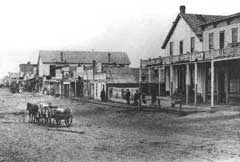
Front Street of Dodge City in 1876
In 1876 the population was 1,200 and nineteen businesses were licensed to sell liquor.
During those first years the population varied according to the season, swelling during the summer with the influx of Cowboys, Buyers, Gamblers and Prostitutes. Business houses, dance halls and saloons catered to the Texas trade. Saloon keepers renamed their places, Alamo and Lone Star and served brandies, liqueurs and the latest mixed drinks. Ice usually was available so even beer could be served cold. Some saloons advertised anchovies and Russian caviar on their cold menus. Gambling ranged from a game of five cent "Chuck-aluck" to thousand dollar poker pots. Many saloons offered some type of musical entertainment - a piano player, a singer, or as in Chalk Beeson's Long Branch, a five piece orchestra. Beeson also organized and led the famous Cowboy Band which entertained all over the west at cattlemen's conventions, concerts, dances and in Washington, D.C. at the inauguration of President Harrison.
By 1882 Dodge City was the "Cowboy Capital" of the West.
Fort Dodge was closed in 1882 and by 1886, the cattle drives had ended because of a ban on Texas cattle due to an disease outbreak. An illustrious period of history was over.
However, the citizens were resilient, and turned to farming and cattle ranching. Today, Dodge City has growing population of over 25,000, is a major agricultural center, as a supply and trade center for a large wheat-growing region and a major cattle processing and shipping-point, and is a regional hub for shopping and entertainment.
To learn more about the history of the American West, visit www.americanwest.com.


